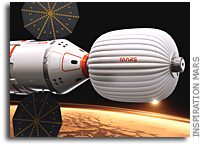Inspiration Mars Foundation Chairman Dennis Tito testifies before House Subcommittee on Space

Tito unveils results of 90-day study on baseline architecture for human mission to Mars
WASHINGTON, D.C. – Dennis Tito, founder and chairman of theInspiration Mars Foundation, testified today before the House Science Subcommittee on Space during a hearing on commercial space. Tito shared the results of a 90-day study undertaken by Inspiration Mars and developed through collaborative efforts with NASA centers and industry partners to define a baseline architecture for a human mission to Mars. The Foundation proposes to send a spacecraft in late 2017 or early 2018 bearing two astronauts, a man and woman, to the far side of Mars and return them to Earth.
Within its Architecture Study Report and through Tito’s testimony today, Inspiration Mars asks Congress and the President to grant an American mission to Mars a place within a launch schedule already set, using rockets and systems already in testing, to meet an objective already set forth.
Speaking to the House subcommittee, Tito recognized that the necessary components for a mission of this magnitude exist, “The work of this subcommittee … gave NASA the Space Launch System (SLS), the Orion program, and new commercial capabilities. We propose to combine all these elements, as we have explained in (the) Architecture Study Report.”
Inspiration Mars’ Architecture Study Report describes the proposed mission architecture to enable the voyage of 314 million miles in 501 days, which requires collaboration through a public-private partnership with NASA. The plan calls for two launches to keep crew and cargo separate, an inherent safety feature to the mission architecture. First, the SLS will lift off from Kennedy Space Center with a four-part payload to place cargo into Earth’s orbit, consisting of: an SLS upper-stage rocket to propel spacecraft from Earth’s orbit to Mars; a service module containing electrical power, propulsion and communication systems; a Cygnus-derived habitat module where the astronauts will live for 501 days; and an Earth Reentry Pod derived from Orion. The second launch will take the crew into orbit aboard a commercial transportation vehicle (selected from competing designs under NASA’s Commercial Crew Program). From there, the crew and Inspiration Mars vehicle stack will rendezvous in orbit using docking procedures perfected by more than 130 trips to the International Space Station.
The report also calls for immediate action to ensure the viability of this approaching mission and rebound America’s human spaceflight program: “In recent years, the most notable movements of American spacecraft have been powered by trucks and barges in the direction of museums, as if all we can afford and aspire to is a careful preservation of past glories.”
During today’s testimony, Tito said, “If I may offer a frank word of caution to this subcommittee: The United States will carry out a Mars flyby mission, or we will watch as others do it – leaving us to applaud their skill and their daring.”
Tito noted there is a window for a mission by a different trajectory, a mission longer by 88 days that could be flown in 2021. Tito stated, “Given Russia’s clear recognition of the value and prestige of accomplishments in human space exploration, and their long-time interest in exploring Mars, my personal belief is that in all likelihood the Energia super-heavy rocket revival announcement signals Russian intent to fly this mission in 2021. Their heavy lift rocket, along with their other designs for modules and the Soyuz, can fly this mission with modest upgrades to their systems. China is also developing suitable capabilities and must surely be contemplating this opportunity to be first to Mars. It is our civic duty to bring this to the attention of the executive and legislative government branches. The 2010 NASA authorization has given America the opportunity to be first to Mars, and we believe it should be taken by launching the mission to Mars in 2017.”
Tito concluded his testimony, “”If Congress and the president will give NASA this great mission, we will be able to say in 2019 that two of our countrymen have just traveled the distance of Mars and back – the longest journey ever made – and that they were the first.”
About Inspiration Mars
A 501(c)3 nonprofit organization, the Inspiration Mars Foundation believes in the exploration of space as a catalyst for growth, national prosperity, knowledge and global leadership. The Inspiration Mars mission will showcase American innovation at its best, generating knowledge, experience and momentum for the next great era of space exploration. It represents an unprecedented, long-duration research opportunity that will lead to new, cutting-edge discoveries, and inspires the next generation of explorers to pursue their destiny through STEM education. This mission is the ultimate demonstration of our collective space exploration capabilities to date.
# # #
MEDIA NOTE:
An Architecture Study Report summary and corresponding fact sheet are housed at www.InspirationMars.org.
MEDIA CONTACTS:
Deanna Wilke
Griffin Communications Group
832-864-7227
281-881-2981 (cell)
Deanna@GriffinCG.com
Jessica Ballard
Griffin Communications Group
281-335-0200
Jessica@GriffinCG.com









